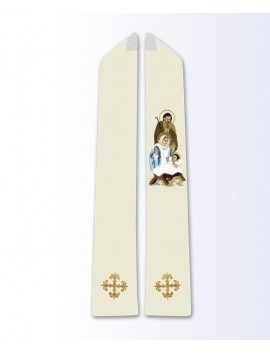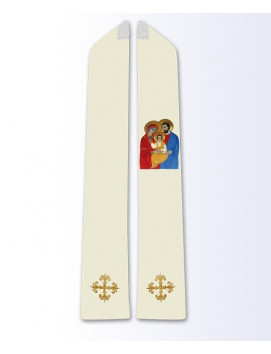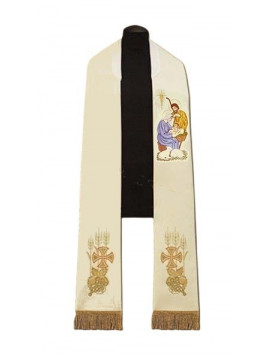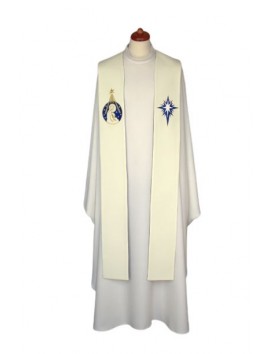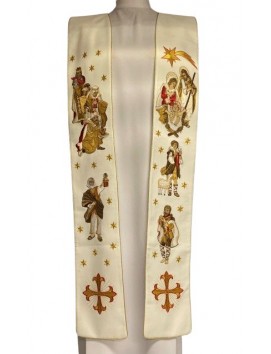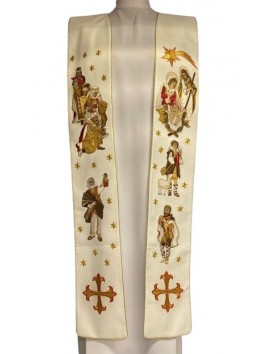No products
Christmas stole
A Christmas stole is a type of liturgical vestment worn by clergy members during the Christmas season. It is a long colored band of cloth worn around the neck with two ends hanging parallel in the front. The Christmas stole is often decorated with embroidered images of Christmas symbols, such as the Nativity scene, poinsettias, or holly. It can be made of various materials, including satin, textured polyester, or silk. The Christmas stole is available in various colors, including white and gold. It is often used during special liturgical celebrations, such as Christmas Eve and Christmas Day services, and is a symbol of the authority and responsibility of the clergy member who wears it. Christmas stoles can be purchased from various online retailers, and can be custom-made to fit the clergy member's style and preferences. Overall, a Christmas stole is a beautiful and meaningful way to show devotion and respect for the Christmas season while enjoying the exquisitely crafted designs that have spiritual significance.
A Christmas stole is a type of liturgical vestment worn by clergy members during the Christmas season. It is a long colored band of cloth worn around the neck with two ends hanging parallel in the front. The Christmas stole is often decorated with embroidered images of Christmas symbols, such as the Nativity scene, poinsettias, or holly. It can be made of various materials, including satin, textured polyester, or silk. The Christmas stole is available in various colors, including white and gold. It is often used during special liturgical celebrations, such as Christmas Eve and Christmas Day services, and is a symbol of the authority and responsibility of the clergy member who wears it. Christmas stoles can be purchased from various online retailers, and can be custom-made to fit the clergy member's style and preferences. Overall, a Christmas stole is a beautiful and meaningful way to show devotion and respect for the Christmas season while enjoying the exquisitely crafted designs that have spiritual significance.
The Enigmatic Charm of the Christmas Stole
The Christmas stole, often draped over the shoulders of clergy during the festive season, carries with it a rich tapestry of history, symbolism, and a touch of mystery. This long, decorated strip of cloth is not just a piece of fabric; it's a narrative woven from the threads of ancient traditions, religious ceremonies, and the universal human desire to celebrate and reflect during the winter solstice. Let's unwrap the story of the Christmas stole, exploring its origins, meanings, and the reasons behind its enduring appeal.
Origins: A Blend of History and Mythology
The Christmas stole, as we know it today, is deeply rooted in both Christian and pre-Christian traditions. Its journey through time is a fascinating tale of adaptation, symbolism, and the blending of cultures.
From Pagan Rituals to Christian Celebrations
Long before the Christmas stole became a staple of Christian liturgy, similar garments were used in pagan rituals. The ancient Romans, for example, wore ceremonial scarves as symbols of authority or to mark special occasions. As Christianity spread, it absorbed and transformed many pagan symbols and traditions, including the use of ceremonial cloths. The transition from a pagan accessory to a Christian vestment symbolizes the broader evolution of Christmas itself—from a celebration of the winter solstice to the birth of Jesus Christ.
The Christian Stole: A Symbol of Service and Celebration
Within the Christian tradition, the stole has come to represent various aspects of faith and clerical duty. It signifies the yoke of Christ, symbolizing the responsibilities and service of the clergy to their communities. During Christmas, the white or gold stole worn by clergy symbolizes joy, purity, and the light of Christ entering the world. This change in color from the more penitential purple of Advent to the celebratory white of Christmas highlights the transition from a period of waiting and preparation to one of joy and celebration.
The Christmas Stole Today: A Multifaceted Symbol
The Christmas stole continues to be a powerful symbol, embodying themes of renewal, celebration, and the intertwining of human and divine.
A Tapestry of Meanings
The Christmas stole is rich in symbolism. Its colors and designs tell stories of faith, hope, and the cyclical nature of life and seasons. White and gold, the colors traditionally associated with Christmas stoles, reflect the joy and splendor of the holiday, reminding us of the light that shines in the darkness.
Beyond the Church: The Stole in Modern Celebrations
While the Christmas stole is primarily a religious garment, its significance spills over into broader cultural celebrations of Christmas. It serves as a reminder of the season's deeper meanings—peace, goodwill, and the potential for renewal and change. In a world that often focuses on the material aspects of the holiday season, the Christmas stole stands as a symbol of the spiritual and intangible gifts of Christmas.
FAQs: Unraveling Common Queries
Q: Can anyone wear a Christmas stole?
A: Traditionally, the Christmas stole is worn by clergy during liturgical services. However, variations of stoles and scarves with holiday themes are popular among the general public as festive accessories.
Q: Does the Christmas stole have different designs?
A: Yes, Christmas stoles can vary in design, often featuring symbols associated with the holiday, such as stars, nativity scenes, and crosses. The specific designs can reflect different aspects of the Christmas story and Christian theology.
Q: How is the Christmas stole different from other liturgical stoles?
A: The main difference lies in the color and specific symbols used. Christmas stoles are typically white or gold, symbolizing joy and purity, and may feature designs specific to the nativity and the holiday season.
In conclusion, the Christmas stole is more than just a piece of religious attire; it's a symbol that bridges the past and present, the human and divine, and the sacred and secular. As we drape ourselves in the festive spirit of the season, the Christmas stole invites us to reflect on the deeper meanings of this time of year—hope, renewal, and the ever-present light in the darkness.

